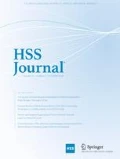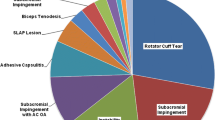Abstract
Background
The use of subacromial corticosteroid injection (CSI) to treat rotator cuff tendinopathy is controversial. We hypothesized that characteristics such as activity level, American Shoulder and Elbow Surgeons (ASES) score, duration of symptoms, and status of the rotator cuff may be prognostic factors for resolution of symptoms postinjection.
Methods
During a 12-month period, consecutive patients with rotator cuff disease were analyzed. Patients received subacromial CSI, oral NSAIDs, and physical therapy. Baseline ASES score, simple shoulder test, an activity scale, and demographic data were recorded. Patients who remained symptomatic and were indicated for surgery were considered failures. Patients that did not undergo surgery were reassessed after a minimum of 1 year.
Results
Forty-nine patients met our criteria. Follow-up was obtained for 81.6%. Sixteen cases (40%) failed conservative treatment at final follow-up (22.4 ± 11 months). CSI were successful in 76.2% of males and 45% of females (p = 0.04). Full-thickness tears were present in 8% of the patients with symptom resolution and 25% of those that failed conservative treatment (p = 0.29). No significant difference was found in age, hand dominance, duration of symptoms, or any of the scoring systems.
Conclusion
It is difficult to predict outcomes after CSI. Our treatment strategy showed a 40% failure rate.
Similar content being viewed by others
References
Aas JM. Local steroid injections in shoulder problems? Tidsskr Nor Laegeforen. 2004;124:2155.
Adebajo AO, Nash P, Hazleman BL. A prospective double blind Dummy placebo controlled study comparing triamcinolone hexacetonide injection with oral diclofenac 50 mg TDS in patients with rotator cuff tendonitis. J Rheumatol. 1990;17:1207–1210.
Akgun K, Birtane M, Akarirmak U. Is local subacromial corticosteroid injection beneficial in subacromial impingement syndrome? Clin Rheumatol. 2004;23:496–500.
Akpinar S, Hersekli MA, Demirors H, Tandogan RN, Kayaselcuk F. Effects of methylprednisolone and betamethasone injections on the rotator cuff: an experimental study in rats. Adv Ther. 2002;19:194–201.
Alvarez CM, Litchfiled R, Jackowski D, Griffin S, Kirkley A. A prospective, double-blind, randomized clinical trial comparing subacromial injection of betamethasone and Xylocaine to Xylocaine alone in chronic rotator cuff tendinosis. Am J Sports Med. 2005;33:255–262.
Ardic F, Kahraman Y, Kacar M, Kahraman MC, Findikoglu G, Yorgancioglu ZR. Shoulder impingement syndrome: relationships between clinical, functional, and radiologic findings. Am J Phys Med Rehabil. 2006;85:53–60.
Arroll B, Goodyear-Smith F. Corticosteroid injections for painful shoulder: a meta-analysis. Br J Gen Pract. 2005;55:224–228.
Balich SM, Sheley RC, Brown TR, Sauser DD, Quinn SF: MR imaging of the rotator cuff tendon: interobserver agreement and analysis of interpretive errors. Radiology 1997; 204:191–194.
Bamji A. The painful shoulder. Practitioner. 2001 245:1005–7, 1009, 1011–2 passim.
Barr KP. Rotator Cuff Disease. Phys Med Rehabil Clin N Am 2004;15:475–491.
Bartolozzi A, Andreychik D, Ahmad S. Determinants of outcome in the treatment of rotator cuff disease. Clin Orthop Relat Res. 1994;308:90–97.
Bell AD, Conaway D. Corticosteroid injections for painful shoulders. Int J Clin Pract. 2005;59:1178–1186.
Bert J. Shoulder injections for subacromial bursitis. Minn Med. 1996;79:6.
Blair B, Rokito AS, Cuomo F, Jarolem K, Zuckerman JD. Efficacy of injections of corticosteroids for subacromial impingement syndrome. J Bone Joint Surg Am. 1996;78:1685–1689.
Bonafede RP, Bennett RM. Shoulder pain. Guidelines to diagnosis and management. Postgrad Med. 1987 82:185–9, 192–3.
Brophy RH, Beauvais RL, Jones EC, Cordasco FA, Marx RG. Measurement of shoulder activity level. Clin Orthop Relat Res 2005;439:101–8.
Buchbinder R, Green S, Youd JM. Corticosteroid injections for shoulder pain. Cochrane Database Syst Rev. 2008;(1):CD004016.
Dunn WR, Schackman BR, Walsh C, et al. Variation in orthopaedic surgeons’ perceptions about the indications for rotator cuff surgery. J Bone Joint Surg Am. 2005;87:1978–1984.
Editorial: Injecting the painful shoulder. Lancet. 1976;1:27.
Ellman H, Hanker G, Bayer M. Repair of the rotator cuff: end result study of factors influencing reconstruction. J Bone Joint Surg [Am] 1986;68:1136–1144.
Esenyel CZ, Esenyel M, Yesiltepe R, et al. The correlation between the accuracy of steroid injections and subsequent shoulder pain and function in subacromial impingement syndrome. Acta Orthop Traumatol Turc. 2003;37:41–45.
Fearnley ME, Vadasz I. Factors influencing the response of lesions of the rotator cuff of the shoulder to local steroid injection. Ann Phys Med. 1969;10:53–63.
Ginn KA, Cohen ML. Conservative treatment for shoulder pain: prognostic indicators of outcome. Arch Phys Med Rehabil. 2004;85:1231–1235.
Goldberg BA, Nowinski RJ, Matsen FA 3rd. Outcome of nonoperative management of full-thickness rotator cuff tears. Clin Orthop. 2001;382:99–107.
Goupille P, Sibilia J. Local corticosteroid injections in the treatment of rotator cuff tendonitis (except for frozen shoulder and calcific tendonitis). Groupe rhumatologique français de l’épaule (G.R.E.P.). Clin Exp Rheumatol. 1996;14:561–566.
Graber MA. Treating shoulder pain: a randomized trial. J Fam Pract. 1997;45:103–104.
Hollingworth GR, Ellis RM, Hattersley TS. Comparison of injection techniques for shoulder pain: results of a double blind, randomized study. Br Med J (Clin Res Ed). 1983;287:1339–1341.
Johansson K, Oberg B, Adolfsson L, Foldevi M. A combination of systematic review and clinicians’ beliefs in interventions for subacromial pain. Br J Gen Pract. 2002;52:145–152.
Kjellin I, Ho CP, Cervilla V, et al. Alterations in the supraspinatus tendon at MR imaging: correlation with histopathologic findings in cadavers. Radiology 1991; 81:837–841.
Klauser A, Frauscher F. Treatment of shoulder complaints. Lancet. 2004; 363:491–492.
Local corticosteroid injections. Br Med J. 1969;3:102–104.
Naredo E, Cabero F, Beneyto P, et al. A randomized comparative study of short term response to blind injection versus sonographic-guided injection of local corticosteroids in patients with painful shoulder. J Rheumatol. 2004;31:308–314.
Ostor AJ, Ricards CA, Prevost AT, Hazleman BL, Speed CA. Interrater reproducibility of clinical tests for rotator cuff lesions. Ann Rhem Dis 2004;63:1288–1292.
Plafki C, Steffen R, Willburger RE, Wittenberg RH. Local anaesthetic injection with and without corticosteroids for subacromial impingement syndrome. Int Orthop. 2000;24:40–42.
Quinn SF, Sheley RC, Demlow TA, Szumowski J: Rotator cuff tendon tears: evaluation with fat-suppressed MR imaging with arthroscopic correlation in 100 patients. Radiology 1995;195:497–500.
Rafii M, Firooznia H, Sherman O, et al.: Rotator cuff lesions: signal patterns at MR imaging. Radiology 1990;177:817–823.
Reinus WR, Shady KL, Mirowitz SA, Totty WG: MR diagnosis of rotator cuff tears of the shoulder: value of using T2 weighted fat saturated images. Am J Roentgenol 1995; 164:1451–1455.
Smith, KL, Harryman, DT.,Antoniou J, Campbell, B, Sidles, JA,. Matsen, FA. A prospective, multipractice study of shoulder function and health status in patients with documented rotator cuff tears. J Shoulder Elbow Surg 2000; 9:395–402.
Speed CA. Disease of the rotator cuff. Consider subacromial injection therapy. BMJ. 1993;307:1559.
Speed C, Hazleman B. Shoulder pain. Clin Evid. 2004; 11:1613–1632.
Stitik TP, Foye PM, Fossati J. Shoulder injections for osteoarthritis and other disorders. Phys Med Rehabil Clin N Am. 2004;15:407–446.
Teefey SA, Rubin DA, Middleton WD, Hildebolt CF, Leibold RA, Yamaguchi K. Detection and quantification of rotator cuff tears: comparison of ultrasonographic, magnetic resonance imaging, and arthroscopic findings in seventy-one consecutive cases. J Bone Joint Surg Am 2004; 86-A:708–16.
van der Windt DA, Bouter LM. Physiotherapy or corticosteroid injection for shoulder pain? Ann Rheum Dis. 2003;62:385–387.
White RH, Paull DM, Fleming KW. Rotator cuff tendonitis: Comparison of subacromial injection of a long acting corticosteroid versus oral indomethacin therapy. J Rheumatol. 1986;13:608–613.
Winters JC, Jorritsma W, Groenier KH, Sobel JS, Meyboom-de Jong B, Arendzen HJ. Treatment of shoulder complaints in general practice: long term results of a tendonitis, single blind study comparing physiotherapy, manipulation, and corticosteroid injection. BMJ. 1999;318:1395–1396.
Winters JC, Sobel JS, Groenier KH, Arendzen HJ, Meyboom-de Jong B. Comparison of physiotherapy, manipulation, and corticosteroid injection for treating shoulder complaints in general practice: Randomised, single blind study. BMJ. 1997;314:1320–1325.
Withrington RH, Girgis FL, Seifert MH. A placebo-controlled trial of steroid injections in the treatment of supraspinatus tendonitis. Scan J Rheumatol. 1985;14:76–78.
Wolf BR, Dunn WR, Wright RW. Indications for repair of full-thickness rotator cuff tears. Am J Sports Med 2007 35:1007–16.
Zheng X, Simpson JA, van der Windt DA, Elliott AM. Data from a study of effectiveness suggested potential prognostic factors related to the patterns of shoulder pain. J Clin Epidemiol. 2005;58:823–830.
Acknowledgments
The authors thank Joseph Nguyen for his help with the preparation of the statistics for this manuscript.
Disclosures
Each author certifies that he or she has no commercial associations (e.g., consultancies, stock ownership, equity interest, patent/licensing arrangements, etc.) that might pose a conflict of interest in connection with the submitted article. One or more of the authors has or may receive funding from a biomedical entity that may be perceived as a potential conflict of interest.
Each author certifies that his or her institution has approved the human protocol for this investigation and that all investigations were conducted in conformity with ethical principles of research, and that informed consent for participation in the study was obtained.
Author information
Authors and Affiliations
Corresponding author
Additional information
Level of Evidence: Level IV: Therapeutic study.
Rights and permissions
About this article
Cite this article
Contreras, F., Brown, H.C. & Marx, R.G. Predictors of Success of Corticosteroid Injection for the Management of Rotator Cuff Disease. HSS Jrnl 9, 2–5 (2013). https://doi.org/10.1007/s11420-012-9316-6
Received:
Accepted:
Published:
Issue Date:
DOI: https://doi.org/10.1007/s11420-012-9316-6




